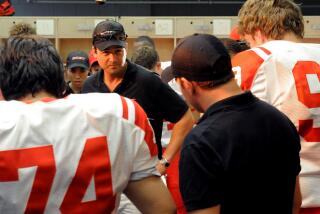Big Shoes to Fill at LACMA : Art: The question of Rusty Powell’s successor at the helm of the Los Angeles County Museum of Art is wide open.
The last time the County Museum of Art’s trustees went looking for a director, it took 18 months to find a qualified candidate who was willing to come to Los Angeles. After being turned down repeatedly, the trustees finally snagged Earl A. (Rusty) Powell III, a 36-year-old executive curator from the National Gallery of Art in Washington. The board took a chance in hiring an unknown and largely unproven quantity back in 1980. But Powell has proven himself so resoundingly that he is now returning to the National Gallery as its director, and the County Museum of Art is looking for his successor.
This time around the search should be considerably easier. “During his 12 years as director, Rusty made tremendous contributions that have put our museum on a level with the finest institutions in the country. He has left the museum in an ideal position to attract another outstanding director,” said board president Robert F. Maguire III.
“It’s a very attractive job,” said John Walsh, director of the J. Paul Getty Museum. “The County Museum of Art is a success story. The museum is financially sound; it has good strong base of support from public and private sectors. And Los Angeles is a much more interesting place than it was 10 years ago.”
A search committee is expected to include Maguire, board chairman Daniel N. Belin and Julian Ganz, chairman of the board’s executive committee, and they will likely hire a head-hunting firm. But the art community is already buzzing about the search. Several weeks ago, when it became apparent that Powell was a serious contender for the National Gallery post, speculation about his successor at LACMA began. When Powell was actually elected to the job, several names emerged on a short list of possibilities.
Of the three other finalists in the National Gallery of Art competition--Roger Mandle, deputy director of the National Gallery; Anne d’Harnoncourt, director of the Philadelphia Museum of Art, and Edmund P. Pillsbury, director of the Kimbell Art Museum in Fort Worth, Tex.--only Mandle is thought to be a possibility, and few insiders believe him to be a likely prospect.
Among the most enthusiastically discussed potential candidates are Peter C. Marzio, director of the Museum of Fine Arts, Houston, and Harry S. Parker III, director of the Fine Arts Museums of San Francisco. Both are perceived as having achieved notable success in their current positions and both are said to have personalities that would equip them to deal with LACMA’s complex directorship.
Other names that have survived the current rumor mill are Robert T. Buck, director of the Brooklyn Museum; Richard Brettell, director of the Dallas Museum of Art; Tom Freudenheim, assistant secretary for museums at the Smithsonian Institution in Washington; James Demetrion, director of the Hirshhorn Museum and Sculpture Garden in Washington; and David Steadman, director of the Toledo Museum of Art. Steadman, a former director of Montgomery Gallery at Pomona College and consultant to collector Norton Simon, and Demetrion, a former curator at the Pasadena Art Museum, are the only names on the speculative list who have worked in Southern California museums.
So the question is whether the County Museum hires an established museum figure, or ends up with another Rusty Powell, someone working in the wings who hasn’t come to national attention.
“Rusty has done a very important job in Los Angeles. He has transformed the museum’s building. He has raised a fortune. He has developed a serious exhibition program. I think he is a logical successor to J. Carter Brown. Who will succeed Rusty is a tougher proposition,” Walsh said.
“It’s a very public job. The director must do a good deal of work with the county, and not everyone is practiced at that. There’s a social and diplomatic side of the job that, in a town as big as Los Angeles, is pretty demanding,” he said.
“Running a full-service museum is a tough bill of goods. The days when museums were a benign place to sit and relax are long gone,” added Maguire.
The new director will face several challenges. “First is revenue and funding. We are too reliant on county and membership funds. We need to work on the endowment and to find imaginative ways of coming up with added revenue so that we can lessen that dependency,” Maguire said.
“Another challenge is that we have to make sure that the museum continues to be relevant to the community . . . The museum-going and museum-supporting population is aging. It is critical to expand the program so that we appeal to young people and recognize the diversity of the city,” he said, noting that the museum must improve its marketing strategies to encourage broader community participation.
One of Powell’s strengths was in attracting an excellent curatorial staff to the museum, Maguire said. The new director must build upon that success to “make the museum increasingly vibrant,” he said.
Finally, Powell’s successor should have an interest in the museum’s long-term architectural program, Maguire said. It might be assumed that the museum’s building days are over, but Maguire--managing partner of Maguire Thomas Partners, a major developer--indicated that plans are afoot to create a larger museum complex on Wilshire Boulevard, with several cultural institutions taking over the old Ohrbach’s and May Co. buildings. At the very least, the museum must carry out plans to coordinate its architectural melange by cladding old buildings in a material that will blend with newer structures, he said.
More to Read
The biggest entertainment stories
Get our big stories about Hollywood, film, television, music, arts, culture and more right in your inbox as soon as they publish.
You may occasionally receive promotional content from the Los Angeles Times.






